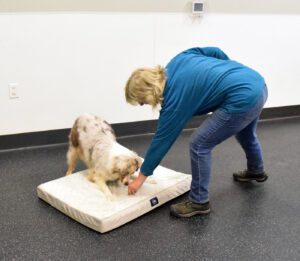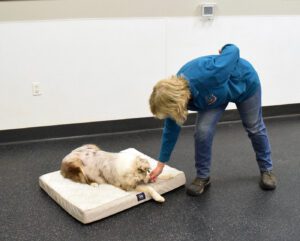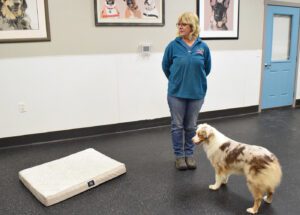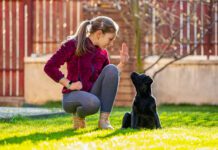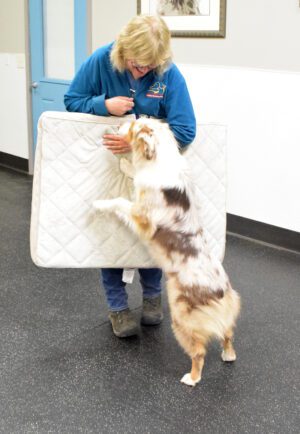
Once you’ve taught your dog a “Go to place” cue you’ll wonder how you ever lived without it! Imagine being able to gently ask your dog to “Mat,” “Bed,” “Place,” or whatever cue you chose to use, and have her willingly and promptly move to her designated spot and lie down. Move her away from the dinner table. Invite her to stop pestering your guest. Send her away from the door when packages are being delivered. Take her mat with you to a restaurant or friend’s house so she has a portable place to park. The applications are endless.
How to Teach Place
Start with a brand-new rug, bed, or blanket that will become her special “go to your place” mat. Then:
- Hold the mat and show interest in it until your dog shows interest in it.
- When your dog shows interest, use your marker (such as the click of a clicker or a verbal marker, like the word “Yes!”) and place a medium-value treat on the mat for her.
- Continue to mark and give a treat on the mat for any mat-related behaviors your dog offers.

If your dog sniffs, touches, or gets on that mat, mark and immediately put a treat on the mat for her. - If she lies down on the mat, mark and feed a high-value treat on the mat. Other On-The-Mat-Behaviors (OTMBs) get medium-value treats.
- Continue to mark any OTMBs, and randomly cue “Down.” When she lies down, mark and treat (with one or two high-value treats).
- After you’ve treated several Downs interspersed with other mat behaviors, pause to see if she offersa down. If she does, mark and feed several high-value treats. If not, continue marking any OTMBs, interspersing Downs with high-value treats for downs.

If your dog spontaneously lies down on the mat, mark and give her a high-value treat or two. Continue to mark and give treats for other behaviors (sit, stand, turn around on) she does on the mat, but save the high-value treats for Downs. - Repeat steps 5 and 6 until your dog Downs when you pause. Any on-the-mat behavior is rewardable, but Downs get the best rewards. She should soon begin offering only downs.
- Now give a release cue, move away from the mat, and invite your dog to follow. When she does, stand quietly – no marking, treats, or praise. Most dogs will return to the mat for more treats. When she does, mark and treat again: medium-value for any behavior, high-value for Downs. Don’t wait for Downs; reinforce for returning to the mat.
- Repeat step 8. Each time you step away go farther away, so your dog learns to go to mat from greater distances. If she’s not lying down on the mat, randomly hold out for a Down.

Release your dog and walk a few steps away. If she returns to the mat, mark and treat; if she offers a Down, mark and give her some high-value treats. - When she quickly returns and lies down each time, increase the duration of the Down in small increments – a few seconds at a time.
- When she’ll go to her mat and lie quietly for an extended time, add your cue. Send her to her “Place” from increasingly longer distances, eventually from anywhere in the house.

When your dog will readily go to her mat and lie down, you can add a cue, such as “Mat!” or “Place!” Now you can start taking the mat to new places to generalize the behavior, and begin introducing distractions (small ones at first). - Finally, add distractions and generalize. Send her to her mat with kindergarten distractions, such as giving a little jump or a clap of your hands. Work up to advanced-level distractions, cueing her to go to her mat when kids are running through the house, food is being prepared, the doorbell rings or visitors enter, etc.
Depending on your dog and your commitment to training, you might accomplish mat training in just a few sessions. If you’re still working on basic good manners or your dog has impulse-control challenges it could take longer. In any case, you’ll be thrilled with this fantastic management tool.


